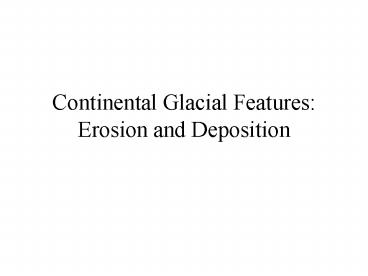Continental Glacial Features: Erosion and Deposition - PowerPoint PPT Presentation
1 / 32
Title:
Continental Glacial Features: Erosion and Deposition
Description:
... pile of material is left called an esker because the flowing water tended ... http://www.canadiangeographic.ca/Landforms/eskers.htm ... – PowerPoint PPT presentation
Number of Views:856
Avg rating:3.0/5.0
Title: Continental Glacial Features: Erosion and Deposition
1
Continental Glacial FeaturesErosion and
Deposition
2
http//www.5tigers.org/talkback/graphics/glaciatio
n.jpg
3
(No Transcript)
4
- Glacial Features Caused by Erosion
- ice sheets were very thick 1.5 km
- gouged huge U-shaped valleys
- made lake basins, eg., the Great Lakes
- glacial meltwater created huge valleys, called
spillways, which today are pathways for much
smaller rivers called misfit streams eg., the
Don River - sand, gravel, rocks, etc. acted like sandpaper in
bottom of ice to erode the surface of the land
created striations aligned with the direction
of ice movement
5
Striations
http//www.geosurv.gov.nf.ca/images/minjpg/63_2.jp
g
6
Features Made by Deposition Till is the material
of varying sizes left behind clay size up to
boulders unsorted (large and small all mixed
together particles are sharp edged because not
rounded by running water. If deposited under an
ice sheet is called a till plain good for growing
crops because well-drained soil forms on top.
7
http//www.geosurv.gov.nf.ca/images/minjpg/66_2.jp
g
8
http//www.geosurv.gov.nf.ca/images/minjpg/66_2.jp
g
Outwash plain notice the material has been
selectively sorted by the flowing water, ie.,
its all basically the same sized material
9
Material carried in the glacier like a conveyor
belt is piled up in front of the ice sheet to
form a moraine.
This material is till and is largely unsorted
(ie., it is all mixed up with different
sizes). Terminal moraines mark the maximum extent
of ice advance.
The larger the moraine the longer the glacier was
stationary, ie., in a state of mass balance.
10
If the climate changes and becomes warmer, the
glacier will retreat and eventually achieve a new
state of mass balance.
11
If the climate changes and becomes warmer, the
glacier will retreat and eventually achieve a new
state of mass balance.
Note that even though the glacier is retreating,
it is still flowing forward. It is just being
ablated (melted) faster than it flows.
12
When the new state of mass balance is reached, a
new moraine is created, called a recessional
moraine. For the skiers Horseshoe Valley and
Mt. St. Louis-Moonstone are on a recessional
moraine.
13
Sometimes two lobes of glacial ice come together
and a moraine forms between them This happened
north of Lake Ontario when there was a pause and
short re-advance of the ice age during the last
retreat the ice lobe left in what would
eventually become Lake Ontario grew north (and
east and west and south) and met the main sheet
moving south they met just north of Toronto -
the Oak Ridges Moraine called interlobate
moraine.
14
Main ice sheet to the north
The ice sheets in retreat there is a pause ...
15
Main ice sheet to the north
. and then a re-advance of the ice for a period
of time
16
Main ice sheet to the north
Oak Ridges - Interlobate Moraine
. and then a re-advance of the ice for a period
of time
17
Oak Ridges - Interlobate Moraine
Toronto
18
The previous features are examples of moraines
formed by continental glaciation. Moraines are
also formed by alpine glaciation.
http//www.canadiangeographic.ca/Landforms/moraine
s.htm
19
Drumlins are egg-shaped hills oriented to the
direction of ice movement usually in clusters
or field about 200/300 in S. Ontario near
Peterborough.
Steep face indicates direction ice came from.
20
Drumlins in a lake in Kejimkujik National Park,
NS. http//sts.gsc.nrcan.gc.ca/page1/landf/atlanti
c/nova/kej/drumlins.htm
21
http//www.zephryus.demon.co.uk/geography/resource
s/glaciers/drum.html
22
http//www.geol.umd.edu/kaufman/ppt/chapter14c/sl
d001.htm
23
Rivers flowing under the ice sheet in tunnels
carry a lot of sediment some of the material
gets deposited on the bottom of the tunnel when
the ice melted the long often windy pile of
material is left called an esker because the
flowing water tended to carry away the finer
particles eskers are made of many sand and gravel
and have been exploited for the aggregate
industry.
The flowing water of the melt water streams
selectively sorted the sediments finer
particles laid down in lakes whereas coarser
particles were left in rivers.
http//www.canadiangeographic.ca/Landforms/eskers.
htm
24
http//www.gov.ns.ca/natr/meb/field/vista2.htm
25
When the ice sheets started to melt about 15,000
years ago, huge amounts of water poured off the
ice and large lakes were created in front of the
sheets huge quantities of sediment were
deposited in these lakes (called glacial ponds)
today they are large flat areas and have fertile
soils called lake plains eg., Great Lakes
Lowlands southern Manitoba (Lake Agassiz).
26
http//www.dnr.state.mn.us/rprp/claycounty/lakeaga
ssiz.html
27
As the ice begins to melt, meltwater collects in
front of the ice.This is called glacial ponding
28
The ice age ends and the ice sheets retreat.
Sediments
29
The ice age ends and the ice sheets retreat.
Sediments
30
Glacial ponding drains away
When ice retreats, land rebounds
Sediments
31
Sediments remain behind and make for excellent
soil.Called lake plains.
When ice retreats, land rebounds
Sediments
32
In some areas the ocean flooded inland quite a
way during the period of ice retreat because the
land was depressed from the weight of the ice
also created fertile areas, eg., St. Lawrence
River valley lowlands sand bars, etc. left
behind. This is called marine overlap.































